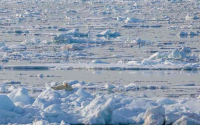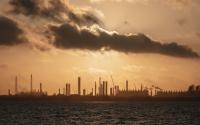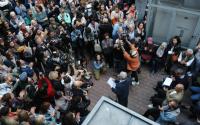25 May 20008Alexei BarrionuevoTruthout
Sao Jose Dos Campos, Brazil - Gilberto Camara, a scientist who leads Brazil's national space agency, is more at ease poring over satellite data of the Amazon than being thrust into the spotlight.
But since January, Dr. Camara has been at the center of a political tug-of-war between scientists and Brazil's powerful business interests. It started when he and his fellow engineers released a report showing that deforestation of Brazil's portion of the rainforest seemed to have shot up again after two years of decline.
Since then, Dr. Câmara, who leads the National Institute for Space Research here, has found himself having to defend his agency's findings against one of Brazil's richest and most powerful men: Blairo Maggi, who is governor of the country's largest agricultural state, Mato Grosso, and a business owner known as the "Soybean King."
Governor Maggi was exercised enough by the report - which led to harsh measures stifling business in his state - that he asked for, and was granted, a meeting with the president, Luiz Inácio Lula da Silva.
The stakes could not be higher for Mr. da Silva. Stewardship of the Amazon has always been a touchy subject, with many Brazilians fearful that world powers would try to impose their standards on the rainforest.
In recent years, the debate over the Amazon has intensified, with many outside the country seeing an intact rainforest as a key to controlling global warming. At the same time, Brazil's economy has taken off - largely because of businesses that are claiming more of the Amazon's land for crops and livestock, and more of its trees for logging.
Mr. da Silva has spent the last several years walking a careful line, trying to maintain his image as Brazil's first "green" president, which has gained him international cachet, without threatening Brazil's agriculture industry at a time of soaring grain and meat prices.
Dr. Câmara's findings made the president's balancing act harder and turned up the heat on what had been a long-simmering battle between businesses and environmentalists.
It did not help that the scientists' report, released in January, relied heavily on progressive deforestation, a relatively new measure that is is widely accepted by environmentalists but that Governor Maggi contends is tantamount to lying. The space agency argues that this slower-paced deforestation, where parts of the forest are thinned out little by little rather than at once, can be just as devastating.
The criticism of the report worried scientists in and out of Brazil, including Dr. Câmara. "Science," he said, "should not bow to authority."
The space agency, known as INPE, reported in January that deforestation had hit an estimated 4,300 square miles between August and December of last year. If that pace continues, the yearly total for deforestation would jump; the number was approximately 6,900 square miles from August 2006 to August 2007.
The agency's data also showed that 54 percent of the deforestation had occurred in Mato Grosso, Governor Maggi's state, where the scientists said ranchers and loggers pushed farther into the rainforest.
Some of the deforestation is legal. Owners are allowed to clear 20 percent of their land in the rainforest.
Nonetheless, the report was a headache for the government. Mr. da Silva has received international attention in recent years for the country's growing biofuels program and for the recent two-year drop in deforestation. Suddenly environmentalists across the world were again criticizing Brazil's efforts to save the rainforest.
The attacks on the space agency made some environmentalists worry publicly that the president might cave in to pressure from businesses. Environmentalists became even more alarmed when Marina Silva, Brazil's environmental minister and a respected rainforest defender, resigned this month. While leaving, she spoke of heavy pressures being exerted by industry-minded governors, including Governor Maggi, to reverse the federal crackdown on destruction of the forest.
Still, Mr. da Silva responded to the space agency's report with tough measures, including imposing credit restrictions on those found to be involved in illegal forest-clearing and creating a Arc of Fire, a multi-agency police operation that conducts surprise raids to catch illegal loggers.
The space agency has two systems for measuring deforestation. Prodes, a yearly satellite analysis, measures deforested areas as small as about 15 acres, while Deter, a lower-resolution system, maps areas greater than about 60 acres in real-time, giving law enforcement information to act quickly to stop further destruction.
The dispute over the space agency's figures has centered on the information provided by Deter.
In the past, Dr. Câmara said, the agency included mostly large swaths of cleared land in its analysis. But environmental researchers have been clamoring for years for satellite researchers to expand monitoring to include areas thinned by logging and surface fires, rather than just areas that have been clear cut.
The agency uses the term progressive deforestation to refer to the slower form of forest degradation that has become increasingly common in the Amazon in recent years and which Dr. Câmara said the agency began including in its analysis in 2005.
The latest deforestation alerts have shown that about one-third of newly deforested areas were from progressive degradation, of which more than 75 percent were "severely degraded," he said.
"We had to ask ourselves what happened between forest and clear-cut," said Dr. Câmara, 52, who has been with the agency for 26 years. "With a view that if you are going to do prevention and enforcement, you need to be there as rapidly as possible."
In other words, if farmers, loggers and others are clearing illegally, but slowly, the government, by identifying thinned-out areas, has a better chance to catch them before a large area has been affected.
"We are satisfied with the technology we have," Dr. Câmara said. "It is the largest use of remote sensing data for environmental protection worldwide on a systematic basis of any country."
But for Governor Maggi, who leads the state that has become a locomotive in Brazil's surging agriculture industry, news that Mato Grosso was once again the worst deforestation offender was difficult to accept. While he is lauded by many for pioneering Brazil's expansion into the world soybean market, his pro-industry stance and actions as head of a soybean-growing business have made him a frequent target of environmentalists. Greenpeace gave him the Golden Chainsaw Award in 2005 for being the Brazilian who most contributed to the destruction of the rainforest.
Governor Maggi's chief of staff, Alexander Torres Maia, did not respond to phone calls seeking comment, and he did not reply to a list of questions sent via e-mail last week.
In recent years, critics say Governor Maggi has softened his all-out defense of the rights of businesses out of political necessity. But that did not stop his administration from challenging the satellite data. Officials in Mato Grosso said that the state's environmental agency had never heard of progressive deforestation.
"We could see this wasn't deforestation, it was burning of fields and old deforestation," Luis Henrique Chaves Daldegan, Mato Grosso's environment secretary, said in an interview.
Mato Grosso's environmental agency worked to gather evidence to prove the space agency had overreached. Technicians compared satellite images dating from 2000, went to disputed locations and shot photos of what was there today. Mr. Daldegan said the pictures proved that the space agency was declaring land that had been deforested as far back as 2000 as newly cleared.
On March 25, the state agency provided Dr. Câmara with a detailed report that included 854 photos of areas in Mato Grosso that the space agency had included in its tally. The state report contended that only 10 percent of the areas had recently been deforested.
Dr. Câmara put 10 of the 50 specialists that had produced the deforestation analysis onto the task of analyzing Mato Grosso's photos and data. They worked intensely for six weeks, he said, sometimes time-stamping their analysis of the photos after midnight.
"There was clearly a sense of urgency," Dr. Câmara said.
In the end, the space agency said that 96 percent of its initial assessments had been correct.
"INPE is very proud, and the internal pressures were almost stronger than the external pressures to show that science would win out," Dr. Câmara said. He did, however, agree to try using higher-resolution satellites in the future to improve the reliability of his agency's analysis.
Mr. Daldegan said he is still not satisfied.
"We don't think this is the end of the story," Dr. Câmara said. "They did not ask us to stop doing this data. So this was a step forward."
-------
Andrew Downie contributed reporting from Sao Paulo, Brazil.






